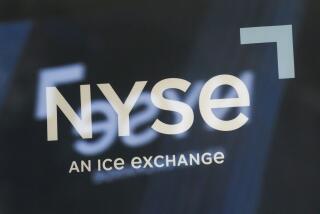New Inflation-Linked Bond Can Fill a Niche
If you’re a small saver, a doting grandparent or one of the millions of Americans already buying U.S. Savings Bonds, the new inflation-indexed version announced Wednesday could be right for you.
Highly conservative investors in top tax brackets might also give the new bonds a look.
But for the vast majority of investors, the so-called I-bonds simply can’t compete with the inflation-fighting power of stocks and stock mutual funds, or with the higher potential returns of conventional Treasury securities.
I-bonds, which will come in denominations ranging from $50 to $10,000, are a significant variation on the staid Series EE Savings Bond. The bonds, unveiled by the Treasury Department on Wednesday, purport to protect investors’ buying power by combining a fixed-rate return, which remains the same for the life of the bond, with a variable rate that’s adjusted every six months for inflation.
Regular Series EE Savings Bonds have some inflation protection, since their interest rate is pegged to the five-year Treasury note, and that tends to move up as prices rise. The I-bond’s inflation link will be more direct: The variable rate is based on changes in the government’s consumer price index for urban consumers.
If inflation soars to 10% in any six-month period, for example, I-bond investors get the 10%, plus whatever their fixed rate was when they bought the bond.
*
Thus, I-bonds could be a great deal if you think inflation is going to soar. Inflation erodes the value of regular government or corporate bonds.
But if you think prices will decline, the bonds could backfire.
If consumer prices fall, the interest rate adjustment could conceivably erase the bond’s yield. If the bond’s fixed rate is 3.5% and consumer prices were to drop 4%, the bond’s yield would drop to 0%--although your principal and all accrued interest would be preserved.
Contrast that with regular government or corporate bonds, which gain in value when inflation and interest rates drop.
We haven’t seen significant deflation since the Great Depression. But for the very risk-averse--and Savings Bond buyers are nothing if not that--that slim chance might be too big to take.
You will be able to buy I-bonds through banks or payroll-deduction plans, just like regular Savings Bonds. But now you’ll pay $50 for a $50 bond, $100 for a $100 bond and so on--a long overdue change from Series EE bonds that are sold for half their face value, which makes it tough to determine how much you’re earning.
The bonds accrue interest for 30 years, although you can redeem them after as little as six months.
The low minimums make the bonds a welcome alternative for the small saver, who is priced out of many investments by high minimums, big fees or ongoing investment requirements.
And as with regular Savings Bonds, you don’t receive your accrued interest until you redeem the bond, at which point you pay only federal tax--Savings Bonds are exempt from state and local taxes.
*
How the bonds compare with Series EE bonds, and with other low-risk investments, will depend on the I-bond’s fixed rate--which won’t be announced until Sept. 1, when the bonds go on sale.
Treasury Deputy Secretary Lawrence Summers said he is confident the rate will be “significantly above 3%”--the absolute minimum needed, at current interest and inflation rates, to compete with regular Savings Bonds’ yield of 5.06%.
Dan Pederson, president of Savings Bond Informer Inc. in Detroit, said he would like to see a fixed rate closer to 3.5%, especially if inflation continues to average around 1.7%.
“If they set something that’s too low, it could squash the party before the party got going,” Pederson said.
Still, those yields pale beside the nearly 11% historical annual return of stocks, which is why most long-term investors should keep the bulk of their money working for them in equities.
*
Liz Pulliam covers personal finance, banking and insurance. She can be reached at [email protected].
More to Read
Inside the business of entertainment
The Wide Shot brings you news, analysis and insights on everything from streaming wars to production — and what it all means for the future.
You may occasionally receive promotional content from the Los Angeles Times.









